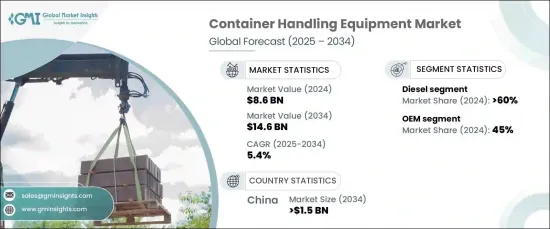
|
시장보고서
상품코드
1664873
컨테이너 핸들링 장비 시장 기회, 성장 촉진요인, 산업 동향 분석 및 예측(2025-2034년)Container Handling Equipment Market Opportunity, Growth Drivers, Industry Trend Analysis, and Forecast 2025 - 2034 |
||||||
세계의 컨테이너 핸들링 장비 시장은 2024년 86억 달러로 평가되었고 2025년부터 2034년까지 연평균 복합 성장률(CAGR) 5.4%의 견조한 성장이 전망되고 있습니다.
이 성장은 국제 무역 증가와 컨테이너 화물 선호 증가에 힘입어 효율적인 컨테이너 취급 솔루션에 대한 수요가 증가하고 있기 때문입니다. 세계 공급망이 복잡해짐에 따라 크레인, 스태커, 자동화 기술 등의 고급 시스템의 채용이 급속히 증가하고 있습니다. 항만 확장과 인프라 업그레이드에 대한 투자는 현대 물류의 진화하는 수요에 대응하기 위해 최신 장비의 필요성을 더욱 가속화하고 있습니다.

시장은 추진력별로 디젤, 전기, 하이브리드 시스템으로 구분됩니다. 디젤 엔진 탑재 장비는 2024년에 60%의 압도적 점유율을 차지했으며, 2034년에는 60억 달러에 달할 것으로 예측됩니다. 디젤은 신뢰성, 확립된 인프라, 비용 효율성으로 인해 인기를 얻고 있습니다. 디젤은 고출력을 실현하기 때문에 특히 전기 인프라가 제한된 환경에서의 중공업에 이상적입니다. 디젤 파워 시스템의 다용도와 신뢰성은 특히 대규모 항만과 물류 허브에서 우위를 유지할 수 있도록 합니다.
| 시장 범위 | |
|---|---|
| 시작 연도 | 2024년 |
| 예측 연도 | 2025-2034년 |
| 시작 금액 | 86억 달러 |
| 예측 금액 | 146억 달러 |
| CAGR | 5.4% |
용량은 10톤 이하, 10-50톤, 50톤 이상으로 나눌 수 있습니다. 용량 10톤 이하의 부문은 합리적인 가격, 유연성, 업계를 불문하고 널리 사용되고 있기 때문에 시장을 선도하고 있습니다. 이 시스템은 중간 규모의 화물을 취급하는 창고, 제조 시설, 항구에서 자주 볼 수 있습니다. 대용량 기기에 비해 저비용이기 때문에 폭넓은 사업자를 이용할 수 있어 시장에서의 우위성이 더욱 강해지고 있습니다.
중국의 컨테이너 핸들링 장비 시장은 2024년 세계 점유율의 30%를 차지했으며 2034년까지 15억 달러를 창출할 것으로 보입니다. 중국의 리더십은 강력한 생산 능력, 비용 효율적인 생산, 항만 인프라에 대한 전략적 투자로 인한 것입니다. 세계 무역 강국인 중국은 대규모 생산 능력과 경쟁력 있는 가격 설정을 활용하여 컨테이너 핸들링 장비 수요 증가에 대응하고 시장에서 중요한 역할을 하고 있습니다.
목차
제1장 조사 방법과 조사 범위
- 조사 디자인
- 조사 접근
- 데이터 수집 방법
- 기본 추정과 계산
- 기준연도의 산출
- 시장추계의 주요 동향
- 예측 모델
- 1차 조사와 검증
- 1차 소스
- 데이터 마이닝 소스
- 시장 정의
제2장 주요 요약
제3장 업계 인사이트
- 업계 생태계 분석
- 공급자의 상황
- 제조업체
- 기술 공급자
- 유통업체
- 최종 사용자
- 이익률 분석
- 기기의 비용 내역
- 기술과 혁신의 전망
- 특허 상황
- 이용 사례
- 주요 뉴스·이니셔티브
- 규제 상황
- 영향요인
- 성장 촉진요인
- 세계무역과 컨테이너화물의 성장
- 자동화와 디지털 기술의 채용
- 항만의 확장과 인프라 개발
- 기기의 기술적 진보
- 업계의 잠재적 리스크·과제
- 높은 초기 자본 투자
- 운용·보수비용
- 성장 촉진요인
- 성장 가능성 분석
- Porter's Five Forces 분석
- PESTEL 분석
제4장 경쟁 구도
- 서론
- 기업의 시장 점유율 분석
- 경쟁 포지셔닝 매트릭스
- 전략 전망 매트릭스
제5장 시장 추계·예측 : 기기별(2021-2034년), 10억 달러
- 주요 동향
- 자동 스태킹 크레인(ASC)
- 빈 컨테이너 취급 지게차(FLT)
- 적재 지게차(FLT)
- 이동식 항만 크레인(MHC)
- 레일 장착 갠트리(RMG) 크레인
- 리치 스태커
- 고무 타이어 갠트리(RTG) 크레인
- 선박에서 해안으로 운반하는(STS) 크레인
- 기타
제6장 시장 추계·예측 : 용도별(2021-2034년), 10억 달러
- 주요 동향
- 항만 터미널
- 철도 터미널
- 내륙 컨테이너 디포(ICD)
- 물류 허브
제7장 시장 추계·예측 : 추진력별(2021-2034년), 10억 달러
- 주요 동향
- 디젤
- 전기
- 하이브리드
제8장 시장 추계·예측 : 용량별(2021-2034년), 10억 달러
- 주요 동향
- 10톤 이하
- 10-50톤
- 50톤 이상
제9장 시장 추계·예측 : 지역별(2021-2034년), 10억 달러
- 주요 동향
- 북미
- 미국
- 캐나다
- 유럽
- 영국
- 독일
- 프랑스
- 스페인
- 이탈리아
- 러시아
- 북유럽
- 아시아태평양
- 중국
- 인도
- 일본
- 한국
- 뉴질랜드
- 동남아시아
- 라틴아메리카
- 브라질
- 멕시코
- 아르헨티나
- 중동 및 아프리카
- UAE
- 남아프리카
- 사우디아라비아
제10장 기업 프로파일
- Konecranes
- Cargotec
- Liebherr Group
- ZPMC(Shanghai Zhenhua Heavy Industries Company)
- Terex
- Doosan Heavy Industries &Construction
- Hyster-Yale Materials Handling
- Toyota Industries
- Mitsubishi Heavy Industries
- SANY Group
- Caterpillar Inc.
- Hyundai Heavy Industries
- Kalmar
- Manitowoc Crane Group
- STILL GmbH
- Jungheinrich AG
- Palfinger AG
- TMEIC Corporation
- Furukawa Electric Co., Ltd.
- ABUS Kransysteme GmbH
The Global Container Handling Equipment Market was valued at USD 8.6 billion in 2024 and is expected to grow at a robust CAGR of 5.4% from 2025 to 2034. This growth is driven by the increasing demand for efficient container handling solutions, fueled by rising international trade and the growing preference for containerized cargo. As global supply chains become more complex, the adoption of advanced systems such as cranes, stackers, and automated technologies is rapidly increasing. Investments in port expansions and infrastructure upgrades are further accelerating the need for state-of-the-art equipment to meet the evolving demands of modern logistics.

The market is segmented by propulsion into diesel, electric, and hybrid systems. Diesel-powered equipment held a dominant 60% share in 2024 and is projected to reach USD 6 billion by 2034. Diesel continues to be a popular choice due to its reliability, well-established infrastructure, and cost-effectiveness. It delivers high power output, making it ideal for heavy-duty operations, especially in environments with limited electric infrastructure. The versatility and dependability of diesel-powered systems ensure they will maintain their lead, particularly in large-scale ports and logistics hubs.
| Market Scope | |
|---|---|
| Start Year | 2024 |
| Forecast Year | 2025-2034 |
| Start Value | $8.6 Billion |
| Forecast Value | $14.6 Billion |
| CAGR | 5.4% |
By capacity, the market is divided into up to 10 tons, 10-50 tons, and 50 tons and above. The up to 10 tons capacity segment is leading the market thanks to its affordability, flexibility, and widespread use across industries. These systems are commonly found in warehouses, manufacturing facilities, and ports handling medium-sized cargo. Their lower cost compared to higher-capacity equipment makes them accessible to a wider range of operators, further strengthening their dominance in the market.
The container handling equipment market in China accounted for 30% of the global share in 2024 and is set to generate USD 1.5 billion by 2034. The country's leadership is attributed to its strong manufacturing capabilities, cost-effective production, and strategic investments in port infrastructure. As a global trade powerhouse, China plays a crucial role in the market, leveraging its large-scale production capacity and competitive pricing to meet the growing demand for container handling equipment.
Table of Contents
Chapter 1 Methodology & Scope
- 1.1 Research design
- 1.1.1 Research approach
- 1.1.2 Data collection methods
- 1.2 Base estimates and calculations
- 1.2.1 Base year calculation
- 1.2.2 Key trends for market estimates
- 1.3 Forecast model
- 1.4 Primary research & validation
- 1.4.1 Primary sources
- 1.4.2 Data mining sources
- 1.5 Market definitions
Chapter 2 Executive Summary
- 2.1 Industry 3600 synopsis, 2021 - 2034
Chapter 3 Industry Insights
- 3.1 Industry ecosystem analysis
- 3.2 Supplier landscape
- 3.2.1 Manufacturers
- 3.2.2 Technology providers
- 3.2.3 Distributors
- 3.2.4 End users
- 3.3 Profit margin analysis
- 3.4 Cost Breakdown of equipment
- 3.5 Technology & innovation landscape
- 3.6 Patent landscape
- 3.7 Use cases
- 3.8 Key news & initiatives
- 3.9 Regulatory landscape
- 3.10 Impact forces
- 3.10.1 Growth drivers
- 3.10.1.1 Growth in global trade and containerized cargo
- 3.10.1.2 Adoption of automation and digital technologies
- 3.10.1.3 Port expansion and infrastructure development
- 3.10.1.4 Technological advancements in equipment
- 3.10.2 Industry pitfalls & challenges
- 3.10.2.1 High initial capital investment
- 3.10.2.2 Operational and maintenance costs
- 3.10.1 Growth drivers
- 3.11 Growth potential analysis
- 3.12 Porter’s analysis
- 3.13 PESTEL analysis
Chapter 4 Competitive Landscape, 2024
- 4.1 Introduction
- 4.2 Company market share analysis
- 4.3 Competitive positioning matrix
- 4.4 Strategic outlook matrix
Chapter 5 Market Estimates & Forecast, By Equipment, 2021 - 2034 ($Bn, Units)
- 5.1 Key trends
- 5.2 Automated Stacking Crane (ASC)
- 5.3 Empty Container Handling Forklift Truck (FLT)
- 5.4 Laden Forklift Truck (FLT)
- 5.5 Mobile Harbor Crane (MHC)
- 5.6 Rail Mounted Gantry (RMG) Crane
- 5.7 Reach Stacker
- 5.8 Rubber Tired Gantry (RTG) Crane
- 5.9 Ship to Shore (STS) Crane
- 5.10 Others
Chapter 6 Market Estimates & Forecast, By Application, 2021 - 2034 ($Bn, Units)
- 6.1 Key trends
- 6.2 Port terminals
- 6.3 Railway terminals
- 6.4 Inland Container Depots (ICDs)
- 6.5 Logistics Hubs
Chapter 7 Market Estimates & Forecast, By Propulsion, 2021 - 2034 ($Bn, Units)
- 7.1 Key trends
- 7.2 Diesel
- 7.3 Electric
- 7.4 Hybrid
Chapter 8 Market Estimates & Forecast, By Capacity, 2021 - 2034 ($Bn, Units)
- 8.1 Key trends
- 8.2 Up to 10 tons
- 8.3 10-50 tons
- 8.4 50 tons and above
Chapter 9 Market Estimates & Forecast, By Region, 2021 - 2034 ($Bn, Units)
- 9.1 Key trends
- 9.2 North America
- 9.2.1 U.S.
- 9.2.2 Canada
- 9.3 Europe
- 9.3.1 UK
- 9.3.2 Germany
- 9.3.3 France
- 9.3.4 Spain
- 9.3.5 Italy
- 9.3.6 Russia
- 9.3.7 Nordics
- 9.4 Asia Pacific
- 9.4.1 China
- 9.4.2 India
- 9.4.3 Japan
- 9.4.4 South Korea
- 9.4.5 ANZ
- 9.4.6 Southeast Asia
- 9.5 Latin America
- 9.5.1 Brazil
- 9.5.2 Mexico
- 9.5.3 Argentina
- 9.6 MEA
- 9.6.1 UAE
- 9.6.2 South Africa
- 9.6.3 Saudi Arabia
Chapter 10 Company Profiles
- 10.1 Konecranes
- 10.2 Cargotec
- 10.3 Liebherr Group
- 10.4 ZPMC (Shanghai Zhenhua Heavy Industries Company)
- 10.5 Terex
- 10.6 Doosan Heavy Industries & Construction
- 10.7 Hyster-Yale Materials Handling
- 10.8 Toyota Industries
- 10.9 Mitsubishi Heavy Industries
- 10.10 SANY Group
- 10.11 Caterpillar Inc.
- 10.12 Hyundai Heavy Industries
- 10.13 Kalmar
- 10.14 Manitowoc Crane Group
- 10.15 STILL GmbH
- 10.16 Jungheinrich AG
- 10.17 Palfinger AG
- 10.18 TMEIC Corporation
- 10.19 Furukawa Electric Co., Ltd.
- 10.20 ABUS Kransysteme GmbH
















